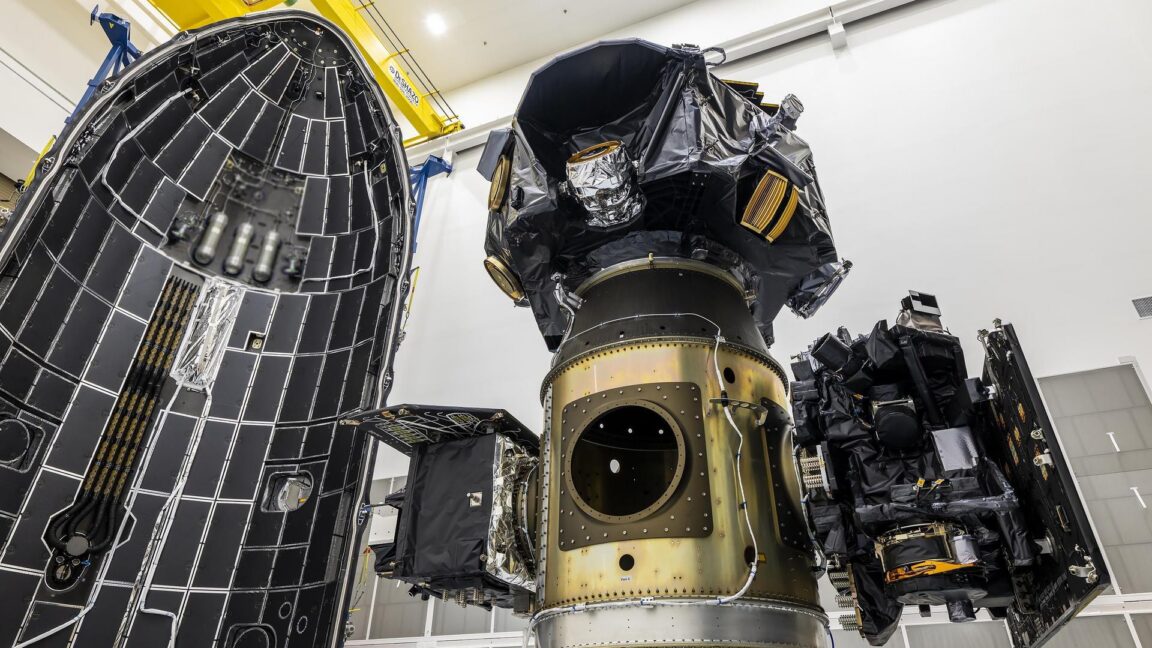Science
SpaceX Launches $1.6 Billion “Cosmic Carpool” to Study Solar Winds

Scientists have successfully launched a SpaceX Falcon 9 rocket carrying three significant missions worth nearly $1.6 billion. The launch took place on March 7, 2024, from NASA’s Kennedy Space Center in Florida. The spacecraft are headed toward the L1 Lagrange point, a gravitational balance point nearly 1 million miles (1.5 million kilometers) from Earth, to conduct crucial studies on solar winds and their effects on our planet.
One of the missions, developed by the National Oceanic and Atmospheric Administration (NOAA), aims to provide real-time data on solar wind to help predict geomagnetic storms that can disrupt power grids, GPS navigation, and satellite operations. The other two missions come from NASA and focus on understanding the boundaries of the Solar System and examining the outermost layer of Earth’s atmosphere.
The Falcon 9 rocket launched at 07:30 EDT (11:30 UTC) and executed a successful trajectory east from Florida’s Space Coast. Following the launch, the reusable first stage booster made a controlled landing offshore, while the rocket’s upper stage engine fired twice to position the three spacecraft into deep space.
Key Missions and Objectives
The principal mission, named the Interstellar Mapping and Acceleration Probe (IMAP), is designed to explore the heliosphere’s outer boundary. IMAP is a spin-stabilized spacecraft shaped like a donut, approximately 8 feet (2.4 meters) in diameter, equipped with ten scientific instruments aimed at mapping this frontier. This region is critical as it serves as a shield against harmful cosmic rays from outside the Solar System.
“IMAP is a mission of firsts,” stated Nicky Fox, associate administrator of NASA’s science mission directorate. “It will be the first spacecraft dedicated to mapping the heliosphere’s outer boundary.” The spacecraft will rotate every 15 seconds to measure ions traveling at speeds of up to 1 million miles per hour in the solar wind and capture interstellar particles.
The mission follows the IBEX mission, which made key discoveries about the heliosphere in 2008. IMAP will expand upon those findings, providing critical insights into how solar particles interact at the heliosphere’s edge.
Supplementary Missions with Unique Goals
Alongside IMAP, the Carruthers Geocorona Observatory is a smaller mission dedicated to studying Earth’s exosphere. This $97 million project includes two ultraviolet imagers designed to capture images of the geocorona, a faint glow generated by hydrogen atoms in the exosphere. The mission is named after George Carruthers, an engineer and solar physicist who first captured images of the geocorona during the Apollo 16 mission in 1972.
“This mission will provide invaluable data about the exosphere, a region we know little about,” said Lara Waldrop, the mission’s principal investigator from the University of Illinois Urbana-Champaign. The Carruthers Observatory will help researchers understand how the exosphere influences solar storm impacts on Earth.
The third mission, the Space Weather Follow On-L1 (SWFO-L1), represents the first operational satellite specifically designed to monitor space weather. Valued at $692 million, this satellite will serve as an early warning system for geomagnetic storms. “SWFO-L1 will give operators of power grids, airlines, and satellites valuable time to prepare for potential disruptions,” noted Irene Parker, deputy assistant administrator at NOAA.
Collaboration and Cost Efficiency
Bundling these three missions onto a single launch vehicle has resulted in significant cost savings, avoiding the need for three separate rockets. This collaborative effort, described by Joe Westlake, director of NASA’s heliophysics division, as the “ultimate cosmic carpool,” highlights the efficiency of modern space missions.
“It’s like a bus,” added Nicky Fox. “You wait for one and then three come at the same time.” This coordinated launch not only maximizes resources but also enhances the scientific return for taxpayers by enabling multiple cutting-edge missions to operate together.
In summary, the successful launch of these three spacecraft marks a significant advancement in our understanding of solar winds and their impact on Earth. As they journey toward the L1 Lagrange point, scientists anticipate groundbreaking discoveries that could reshape our knowledge of space weather and its interactions with our planet.
-

 Science2 months ago
Science2 months agoToyoake City Proposes Daily Two-Hour Smartphone Use Limit
-

 Health2 months ago
Health2 months agoB.C. Review Reveals Urgent Need for Rare-Disease Drug Reforms
-

 Top Stories2 months ago
Top Stories2 months agoPedestrian Fatally Injured in Esquimalt Collision on August 14
-

 Technology2 months ago
Technology2 months agoDark Adventure Game “Bye Sweet Carole” Set for October Release
-

 World2 months ago
World2 months agoJimmy Lai’s Defense Challenges Charges Under National Security Law
-

 Technology2 months ago
Technology2 months agoKonami Revives Iconic Metal Gear Solid Delta Ahead of Release
-

 Technology2 months ago
Technology2 months agoSnapmaker U1 Color 3D Printer Redefines Speed and Sustainability
-

 Technology2 months ago
Technology2 months agoAION Folding Knife: Redefining EDC Design with Premium Materials
-

 Technology2 months ago
Technology2 months agoSolve Today’s Wordle Challenge: Hints and Answer for August 19
-

 Business2 months ago
Business2 months agoGordon Murray Automotive Unveils S1 LM and Le Mans GTR at Monterey
-

 Lifestyle2 months ago
Lifestyle2 months agoVictoria’s Pop-Up Shop Shines Light on B.C.’s Wolf Cull
-

 Technology2 months ago
Technology2 months agoApple Expands Self-Service Repair Program to Canada









